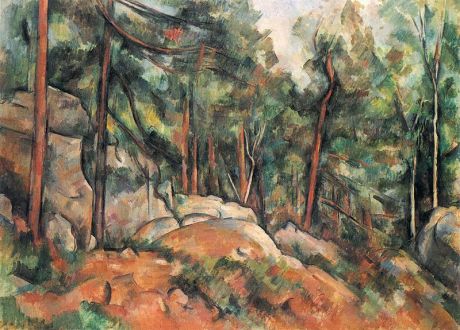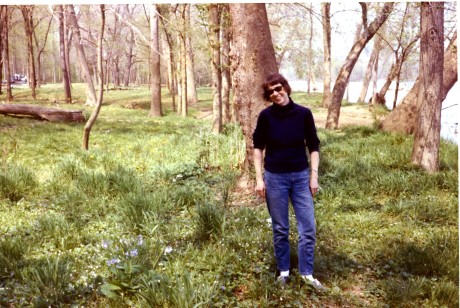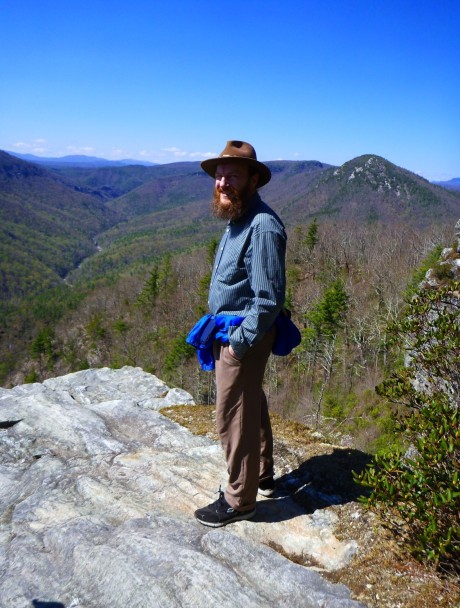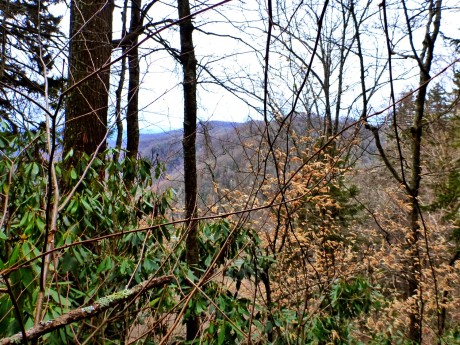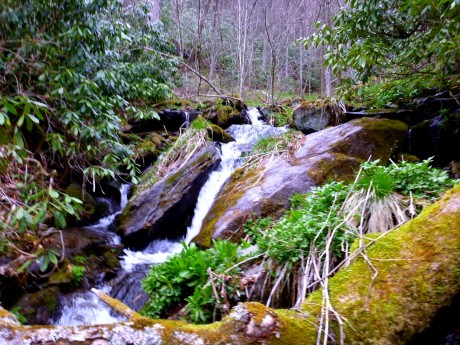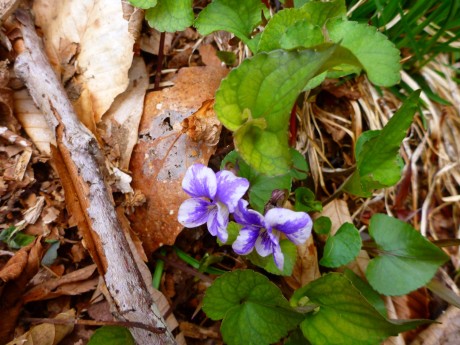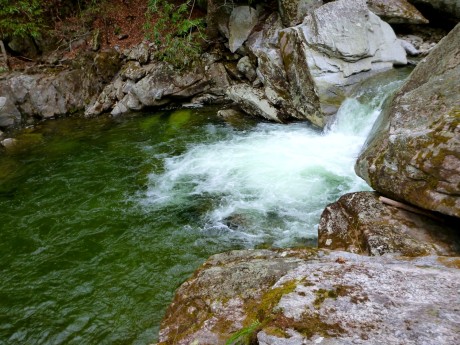Spring in Linville Gorge April 22, 2013
Posted by Jenny in hiking, nature, plants.Tags: car camping, Hawksbill, Linville Gorge, Shortoff Mountain, Table Rock
2 comments
Linville Gorge is a wonderful place to spend a weekend in April. Although the gorge is known more for its crags than its plant life, it is precisely the contrast of the rugged rock formations with the green unfoldings of spring that makes this an incredible place to be at the height of the season’s beautiful turbulence. We had so many lovely and interesting things to look at that it was nearly a case of visual overload.
My companions on this car-camping trip were my old friend Gary from college, his pal Jim, and Jim’s two children Thomas and Julie. We also had a four-legged participant, Aesop. Gary has put in an appearance in this blog quite a few times. He and Jim share a passion for music. Jim plays sax and Gary plays a startling array of instruments ranging from clarinet to piano. They perform regularly in the Raleigh area, and Jim has three regular gigs every week.
Thomas and Julie are twins, both freshmen at UNC-Asheville. Julie is interested in a range of ecological subjects and Thomas is a lit major and a writer. He and I had great conversations on eccentric topics ranging from the calligrams of poet Guillaume Apollinaire to abstract expressionist photography.
At this time of year (up to May 1), it’s possible to camp without a permit at informal dispersed sites along both the eastern and western rims of the gorge. We found a great spot opposite the Hawksbill trailhead. We set up two of our tents on a ledgy site that had views of Table Rock and down into the rolling hills to the southeast. The site had a distinct slope, but the location offset the slight inconvenience of slipping downhill inside the tent. (Velcro on the bottom of the sleeping bag would have helped.) Since we had three tents, we established an annex just down the trail for the largest tent.
After setting up camp, we drove down to the Table Rock trailhead (the lower one, not the Table Rock picnic area) and did a loop going down the Spence Ridge trail, turning onto Little Table Rock trail, and making the steep climb up the mountain. Although none of my companions are regular hikers, they all did great. Incidentally, it was the first time the twins had ever camped.
After a side trip to a pinnacle with great views into the gorge (where the photos above were taken), we connected with the trail from the picnic area (part of the Mountains to Sea trail) and made our assault on the summit of Table Rock.
We descended to the road (FR 210) by way of the continuation of the MST, closing our loop. We dined beside the campfire as the sun set, daylight giving way to the radiance of a brilliant moon. The moon shone so brightly that Thomas was able to read a passage aloud to us from his book without any artificial illumination, which was strangely comical.
It got quite cold overnight but stayed above freezing. After breakfast we struck camp. In the parking lot I ran into an acquaintance, Marshall Weatherman, who was the mastermind behind an outing last December to the Lower Original Scramblers Trail (LOST). He was about to lead a group up Hawksbill and then over to Sitting Bear via one of the many obscure and challenging routes that he knows.
Our hike for the day was to start at Table Rock picnic area and follow the Shortoff trail (yet another part of the MST) to a point on Shortoff Mountain to be determined. The trail follows a narrow ridge with many crags between the picnic area and the Chimneys.
We saw serviceberry (Amelanchier) in bloom everywhere.
We saw irises in bloom, violets of various colors, sand myrtle already in bud, Carolina rhododendron, and many other noteworthy shrubs and trees. Clusters of Carolina hemlock seemed to have escaped the woolly adelgid’s devastation of the Canadian hemlock. The forest of pitch pine and Table Mountain pine had been heavily damaged by pine bark beetle and fires, but large areas remained relatively unscathed. We did see one area from Shortoff Mountain that had been burned all the way down to the mineral soil in a fire that hadn’t even left any charred stumps.
We descended to Chimney Gap, where we had lunch, and climbed up over several humps and bumps of Shortoff Mountain. I saw fothergilla in bloom in that area.
We wished we could have kept going, but when we reached our turnaround time we headed back, tackling the steep climb up to the high, narrow ridge.
Once back at the picnic area, we organized a trip in our two cars into downtown Asheville, where we had a pleasant dinner. Aesop was able to come with us at a place that had outdoor tables (with clear plastic to shelter the tables from the wind). Aesop was very well behaved the whole weekend, though his focus was more on sniffing the ground for moles and other small mammals than on admiring the scenery.
It was a memorable weekend with a great group of people plus one fine upstanding dog.
In search of the 150-foot spruce April 15, 2013
Posted by Jenny in bushwhacking, hiking, nature, plants, Smoky Mountains.Tags: Eastern Native Tree Society, Enloe Creek, Raven Fork, red spruce, Simmons Branch
16 comments
Ever since I read a trip report by members of the Eastern Native Tree Society about finding a record-size red spruce in the Raven Fork area, I’ve wanted to go there myself. In a way my mission was silly. I don’t have the scientists’ instruments for measuring the height of trees. Maybe what it boiled down to is that I just wanted to wander around in that incredibly wild area in the quadrant northwest of the Raven Fork/Enloe Creek junction.
The ENTS team found a spruce in the Simmons Branch valley that they measured as 146.7″ tall and 12’8″ cbh (circumference at breast height). Those dimensions combined make it a national champion, they said. They found another leviathan even taller, 155’3″ tall, but not as thick (10’7″ cbh). They also found all kinds of other wild, weird, gigantic trees, such as an enormous yellow birch with adventitious roots like those of a strangler fig.
But what is it about spruces? When my friend Brian Worley and I went exploring up there yesterday, we saw skeletal hemlocks that were bigger. But spruces are not usually as large as hemlocks, and I’ve developed a special fondness for these dark, dense evergreens that crown the heights with their sharp pointed tops. I always look for the first spruce when I climb a mountain, though it’s usually a baby. And I always look for those dark shapes on the remote beckoning tops of the farthest heights.
On an overcast day with refreshing cold winds, we climbed up the Hyatt Ridge trail and descended to Raven Fork. It was my pleasure to introduce Brian to these places. He is a long-time bushwhacker who lives in East Tennesse and had never visited this area.
We stopped for a rest and a snack at the hemlock boulder on Raven Fork—the one where the Park Service has treated the landmark trees for the woolly adelgid. We admired the stream.
Here came the tricky part—the ENTS report said the team left the Enloe Creek trail “about a third of a mile” past the metal bridge. I actually spent time with my maps and an architect’s ruler, measuring the trail against the map scale. I came up with a plausible departure point. But even if I’d identified the correct spot on the map, we then had to match it to the actual location. I still can’t be certain we selected exactly the same route visited by ENTS, but we left the trail at a nice little stream valley and started to climb.
We climbed from about 3800′ to 4800′ up this valley, finding it remarkably free of thick brush. It seemed too good to be true—and in fact the rhodo-free conditions didn’t last. As we climbed, we found the forest floor carpeted with the infinitely variable shapes of new green leaves.
The way grew progressively steeper, and we passed a cascade.
As we reached the top and got into thicker brush, I took a photo looking south, toward Hughes Ridge and Ace Enloe Ridge.
Suddenly we found ourselves in dense rhodo, standing on the ridge that marks the southern boundary of the Simmons Branch drainage. The ENTS route took them down toward the stream to the northwest. But their description said they’d emerged on the ridge in a heath bald, and we saw no heath in any direction. And as we gazed into the incredibly dense, snarled, wild forest between us and Simmons Branch, we realized that we might have bitten off more than we could chew. We’d gotten a late start, and we were facing the possibility of getting caught out in the dark looking for the national champ.
Since the second 150-foot spruce was located near a saddle between Simmons and the next stream drainage to the west, we decided to keep to the high ground and head over to the saddle. We worked our way through the enchanted forest, seeing many tall spruce and one of the largest sugar maples I’ve ever come across. Even the fungus growths were larger than normal.
We crossed occasional stretches of open ground, but most of the time we fought through rhodo and blackberries. The going was very slow. We reached the saddle and turned west, soon finding the spruce pictured at top. Rhodo hemmed in its base. But as I gazed up the towering trunk, I felt that we were in the presence of a giant. Of course, we’ll never know its actual height or whether it is the second one mentioned in the ENTS report.
We made our way down into the unnamed tributary of Enloe by a small draw choked with rhodo and the thickest blackberry canes I’ve ever seen (thick in their diameter, I mean). Things finally opened up and we were able to make faster progress.
This valley had the opposite gradient than the one we’d ascended by, being steepest toward the bottom. The stream cascaded down over attractive waterfalls, and we finally returned to the trail.
Enloe Creek was plunging along with high water levels. It was beautiful.
All through the day, we saw countless white trillium.
We stopped for a snack beside my favorite Raven Fork pool before making the climb back up to Hyatt Ridge.
We descended along Hyatt Creek in a light, gentle rain. All the plants were once again being nourished by the rain clouds so that they will grow and thrive. Ah, the Smokies in April. Indescribable.
